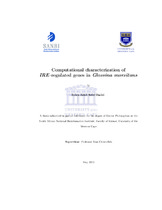| dc.description.abstract | Blood feeding is a habit exhibited by many insects. Considering the devastating impact
of these insects on human health, it is important to focus research on understanding the
biology behind blood-feeding, disease transmission and host-pathogen interactions. Such knowledge would pave the way for developing efficient preventative measures.
Iron an important element for species survival, is at the center of events controlling tsetse’s fitness and reproductive success. Hence, targeting genes involved in iron trafficking and sequestration would present possible means of preventing disease transmission. Considering the dynamic and multi-factorial nature of iron metabolism, a well-coordinated regulatory system is expected to be at work. Despite extensive literature on the mechanism of iron regulation and key factors responsible in maintaining its homeostasis in human, less attention has been given to understand such system in insects, especially the blood-feeding insects. The availability of the genome sequences for several insect disease vectors allows for a more detailed analysis on the identification and characterization of events controlling and preventing iron-induced toxicity following a blood-meal. The International Glossina Genome Initiative (IGGI) has coordinated the sequencing and annotation of the Glossina morsitans genome that has led to the identification of 12220 genes. This knowledge-base along with current understanding of the IRE system in regulating iron metabolism, allowed for investigating the UTRs of Glossina genes for the presence of these elements. Using a combination of motif enrichment and IRE-stem loop structure prediction, an
IRE-mediated regulation was inferred for 150 genes, among which, 72 were identified
with 5’-IREs and 78 with 3’-IREs. Of the identified IRE-regulated genes, the ferritin
heavy chain and MRCK-alpha are the only known genes to have IREs, while the rest
are novel genes for which putative roles in regulating iron levels in tsetse fly have been
assigned in this study. Moreover, the functional inference of the identified genes further
points to the enrichment of transcription and translation. Furthermore, several hypothetical proteins with no defined functions were identified to be IRE-regulated. These include TMP007137, TMP009128, TMP002546, TMP002921, TMP003628, TMP004581, TMP008259, TMP012389, TMP005219, TMP005827, TMP007908, TMP009332, TMP01- 3384, TMP009102, TMP010544, TMP010707, TMP004292, TMP006517, TMP014030, TMP009821 and TMP003060 for which an iron-regulatory mechanism of action may be inferred. We further report 26 IRE-regulated secreted proteins in Glossina, that present good candidates for further investigation pertaining to the development of novel vector control strategies. Using the predicted data on the identified IRE-regulated genes and their functional classification, we derived at 29 genes with putative roles in iron trafficking, where several unknown and hypothetical proteins are included. Thus a novel role is inferred for these genes in cellular binding and transport in the context of iron metabolism. It is therefore possible that these genes may have evolved in Glossina, such that they compensate for the absence of an IRE- regulated mechanism for transferrin. Additionally, we propose 14 IRE-regulated genes involved in immune and stress response, which may indeed play crucial roles at the host pathogen interface through their possible mechanisms of iron sequestration.
Using the subcellular localization analysis, we further categorized the putative IRE regulated genes into several subcellular localizations, where the majority of genes were
found within the nucleus and the cytosol. The detection of the conserved motifs in a set of genes, is an interesting yet sophisticated area of research, that allows for identifying either co-regulated or orthologous genes, while further providing support for the putative function of a set of genes that would otherwise remain uncharacterized. This is based on the notion that co-regulated genes are often coexpressed to carry out a specific function. As such, 14 regulatory elements were identified in the 5’- and 3’-UTRs of IRE-regulated genes, involved in embryonic development and reproduction, inflammation and immune response, signaling pathways and neurogenesis
as well as DNA repair. This study further proposes several IRE-regulated genes as targets for micro-RNA regulation through identifying micro-RNA binding sites in their 3’UTRs. Using a motif clustering approach we clustered IRE-regulated genes based on the number of motifs they share. Significantly co-regulated genes sharing two or more motifs were determined as critical targets for future investigation. The expression map of IRE-regulated genes was analyzed to better understand the events taking place from 3 hours to 15 days following a blood meal. Re-analysis of Anopheles microarray chip showed the significant expression of three cell envelope and transport genes as early response and six as late response to a blood meal, which could indeed be assigned a putative role in iron trafficking. Genes identified in this study with implications
in iron metabolism, whose timely expression allows for maintaining iron homeostasis,
represent good targets for future work. Considering the important role of evolution in species adaptation to habits such as Hematophagy, it is of importance to identify evolutionary signatures associated with these changes. To distinguish between evolutionary forces that are specific to iron-metabolism in blood-feeding insects and those that are found in other insects, the IRE-regulated genes were clustered into orthologous groups using several blood feeding and non-blood feeding insect species. Assessment of different evolutionary scenarios using the Maximum Likelihood
(ML) approach, points to variations in the evolution of IRE-regulated genes between the two insect groups, whereby several genes indicate an increased mutation rate in the
BF-insect group relative to their non-blood feeding insect counterparts. These include
TMP003602 (phosphoinositide3-kinase), TMP009157 (ubiquitin-conjugating enzyme9),
TMP010317 (general transcription factor IIH subunit1), TMP011104 (serine-pyruvate mitochondrial), TMP013137 (pentatricopeptide Transcription and translation), TMP013886 (tRNA(uridine-2-o-)-methyl-transferase-trm7) and TMP014187 (mediator 100kD).
Additionally, we have indicated the presence of positively selected sites within seven
blood-feeding IRE-regulated genes namely TMP002520 (nucleoporin), TMP008942 (eukaryotic translation initiation factor 3), TMP009871(bruno-3 transcript) , TMP010317
(general transcription factor IIH subunit1), TMP010673 (ferritin heavy-chain protein),
TMP011104 (serine-pyruvate mitochondrial) and TMP011448 (brain chitinase and chia).
Thus the results of this study provides an in depth understanding of iron metabolism in
Glossina morsitans and confers important targets for future validations based on which
innovative control strategies may be designed. | en_US |

